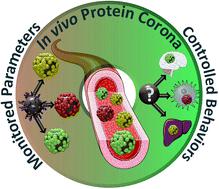当前位置:
X-MOL 学术
›
Nanoscale Adv.
›
论文详情
Our official English website, www.x-mol.net, welcomes your
feedback! (Note: you will need to create a separate account there.)
In vivo protein corona on nanoparticles: does the control of all material parameters orient the biological behavior?
Nanoscale Advances ( IF 4.6 ) Pub Date : 2021-1-13 , DOI: 10.1039/d0na00863j Nimisha Singh 1 , Célia Marets 1 , Julien Boudon 1 , Nadine Millot 1 , Lucien Saviot 1 , Lionel Maurizi 1
Nanoscale Advances ( IF 4.6 ) Pub Date : 2021-1-13 , DOI: 10.1039/d0na00863j Nimisha Singh 1 , Célia Marets 1 , Julien Boudon 1 , Nadine Millot 1 , Lucien Saviot 1 , Lionel Maurizi 1
Affiliation

|
Nanomaterials have a huge potential in research fields from nanomedicine to medical devices. However, surface modifications of nanoparticles (NPs) and thus of their physicochemical properties failed to predict their biological behavior. This requires investigating the “missing link” at the nano-bio interface. The protein corona (PC), the set of proteins binding to the NPs surface, plays a critical role in particle recognition by the innate immune system. Still, in vitro incubation offers a limited understanding of biological interactions and fails to explain the in vivo fate. To date, several reports explained the impact of PC in vitro but its applications in the clinical field have been very limited. Furthermore, PC is often considered as a biological barrier reducing the targeting efficiency of nano vehicles. But the protein binding can actually be controlled by altering PC both in vitro and in vivo. Analyzing PC in vivo could accordingly provide a deep understanding of its biological effect and speed up the transfer to clinical applications. This review demonstrates the need for clarifications on the effect of PC in vivo and the control of its behavior by changing its physicochemical properties. It unfolds the recent in vivo developments to understand mechanisms and challenges at the nano-bio interface. Finally, it reports recent advances in the in vivo PC to overcome and control the limitations of the in vitro PC by employing PC as a boosting resource to prolong the NPs half-life, to improve their formulations and thereby to increase its use for biomedical applications.
中文翻译:

纳米颗粒上的体内蛋白质电晕:所有材料参数的控制是否可以指导生物行为?
纳米材料在从纳米医学到医疗器械的研究领域具有巨大的潜力。然而,纳米粒子(NP)的表面修饰及其物理化学性质未能预测其生物学行为。这需要研究纳米生物界面上的“缺失环节”。蛋白冠 (PC) 是一组与纳米粒子表面结合的蛋白质,在先天免疫系统识别颗粒中发挥着关键作用。尽管如此,体外孵化对生物相互作用的理解仍然有限,并且无法解释体内的命运。迄今为止,已有几篇报告解释了 PC 的体外影响,但其在临床领域的应用非常有限。此外,PC通常被认为是降低纳米车辆靶向效率的生物屏障。但蛋白质结合实际上可以通过在体外和体内改变PC来控制。因此,对PC进行体内分析可以深入了解其生物学效应,并加快向临床应用的转移。本综述表明需要澄清PC在体内的作用以及通过改变其理化性质来控制其行为。它展示了最近的体内进展,以了解纳米生物界面的机制和挑战。最后,报告了体内PC 的最新进展,通过使用 PC 作为增强资源来延长 NP 半衰期,改进其配方,从而增加其在生物医学应用中的使用,从而克服和控制体外PC 的局限性。
更新日期:2021-01-25
中文翻译:

纳米颗粒上的体内蛋白质电晕:所有材料参数的控制是否可以指导生物行为?
纳米材料在从纳米医学到医疗器械的研究领域具有巨大的潜力。然而,纳米粒子(NP)的表面修饰及其物理化学性质未能预测其生物学行为。这需要研究纳米生物界面上的“缺失环节”。蛋白冠 (PC) 是一组与纳米粒子表面结合的蛋白质,在先天免疫系统识别颗粒中发挥着关键作用。尽管如此,体外孵化对生物相互作用的理解仍然有限,并且无法解释体内的命运。迄今为止,已有几篇报告解释了 PC 的体外影响,但其在临床领域的应用非常有限。此外,PC通常被认为是降低纳米车辆靶向效率的生物屏障。但蛋白质结合实际上可以通过在体外和体内改变PC来控制。因此,对PC进行体内分析可以深入了解其生物学效应,并加快向临床应用的转移。本综述表明需要澄清PC在体内的作用以及通过改变其理化性质来控制其行为。它展示了最近的体内进展,以了解纳米生物界面的机制和挑战。最后,报告了体内PC 的最新进展,通过使用 PC 作为增强资源来延长 NP 半衰期,改进其配方,从而增加其在生物医学应用中的使用,从而克服和控制体外PC 的局限性。











































 京公网安备 11010802027423号
京公网安备 11010802027423号